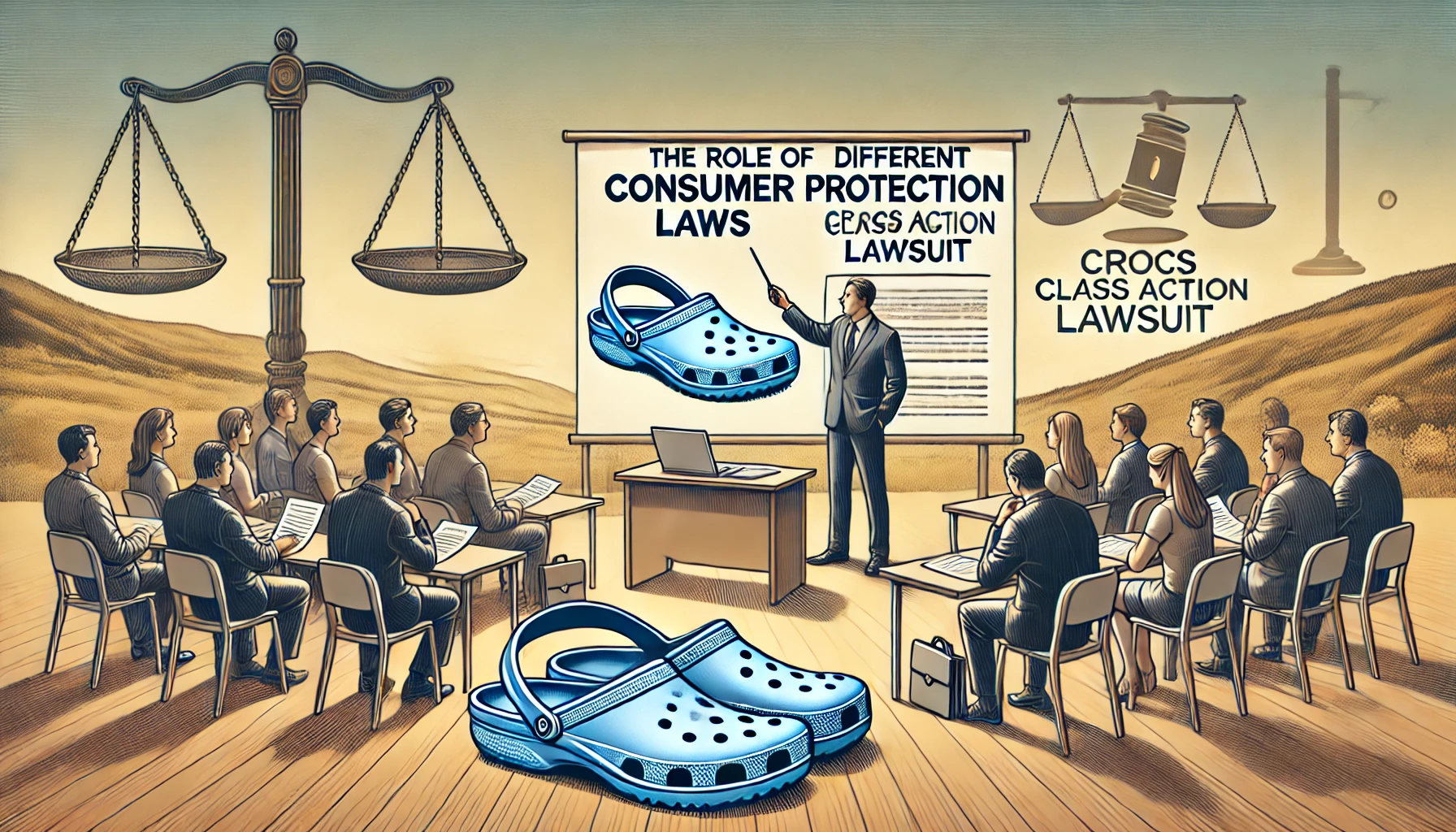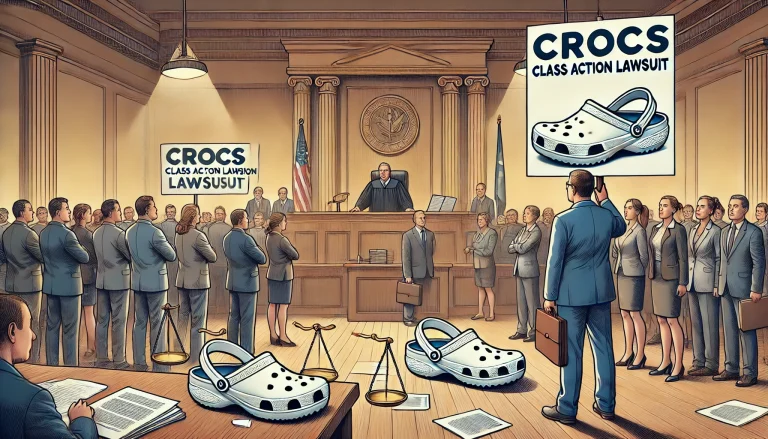The Crocs class action lawsuit has sparked considerable attention in the realm of consumer protection and corporate responsibility. This case centers on claims related to the quality, safety, and marketing practices of the popular footwear brand, raising questions about product standards and transparency in consumer goods.
Understanding the intricacies of the Crocs class action lawsuit is crucial for both consumers and legal experts. The case sheds light on how collective legal action can impact major brands, potentially prompting changes in their practices and policies. It also underscores the importance of companies maintaining high standards to avoid legal challenges.
For those affected by the Crocs class action lawsuit, this case represents an opportunity to seek justice and potentially receive compensation. The lawsuit’s outcome could influence how similar consumer cases are handled in the future, offering a precedent for individuals seeking redress in comparable situations.
What Led to the Crocs Class Action Lawsuit?
The Crocs class action lawsuit originated from consumer dissatisfaction over the product’s quality and durability. Many buyers reported issues such as the shoes deteriorating faster than expected or causing discomfort. This accumulation of complaints led to increased scrutiny, prompting legal action.
A primary reason for the Crocs class action lawsuit was the assertion that the company engaged in misleading advertising. Consumers argued that the brand’s promotional materials overstated the durability and comfort of the product, which did not align with their actual experiences.
Another factor contributing to the Crocs class action lawsuit was the number of reports about safety concerns. Instances of tripping or slipping due to the shoe’s design raised alarms, further fueling legal momentum. These complaints formed the foundation of the class action, uniting affected individuals with similar grievances.
The lawsuit’s initiation underscores the importance of accurate marketing and transparency. For Crocs, maintaining trust with its consumer base became a critical point of focus as the case gained attention.
Consumer Claims and Complaints: Analyzing the Crocs Case
Consumers who joined the Crocs class action lawsuit voiced a range of complaints, predominantly about product durability and comfort. Reports highlighted that many customers experienced early wear and tear, with the shoes losing their shape and support in a shorter time than advertised.

- Key Complaints:
- Durability issues leading to product failure within a few months.
- Safety concerns related to the shoe’s structure and potential for slips.
A significant number of plaintiffs expressed dissatisfaction with the company’s response to complaints. Many reported receiving inadequate or no compensation when they reached out to Crocs’ customer service, prompting them to join the collective legal action. This lack of resolution amplified frustration among consumers, pushing the Crocs class action lawsuit forward.
Additionally, complaints emphasized the discrepancy between marketing claims and reality. Crocs’ reputation as a durable, all-purpose shoe was under scrutiny as consumers felt misled by the company’s promises. This aspect became a cornerstone for their collective legal argument.
Analyzing the consumer feedback and legal briefs revealed the potential for widespread impact on other product-centric companies. The Crocs class action lawsuit showcased how negative consumer experiences could cascade into significant legal ramifications.
Key Legal Issues at the Center of the Crocs Case
At the heart of the Crocs class action lawsuit are significant legal questions surrounding product quality and consumer rights. One of the main legal concerns was whether Crocs violated consumer protection laws by misrepresenting their product’s performance. Plaintiffs argued that the company’s claims did not match reality, leading to legal challenges over false advertising.
Another legal issue in the Crocs class action lawsuit involves warranty claims. Consumers contended that Crocs failed to uphold promises made through implied warranties, which guaranteed a certain level of product quality. The breach of these implied agreements became a central argument in court.
Additionally, product liability surfaced as an essential part of the case. Claims about the safety of Crocs, including potential slip and trip hazards, called into question whether the company sufficiently tested their product for common risks. The lawsuit sought to determine if Crocs was negligent in designing and marketing a potentially unsafe product.
The Crocs class action lawsuit also examined the company’s compliance with federal regulations related to consumer goods. This included whether Crocs adhered to legal guidelines about product disclosures and consumer safety assurances.
How Class Action Lawsuits Affect Popular Brands
Class action lawsuits, like the Crocs class action lawsuit, can have substantial impacts on popular brands. For companies, these legal actions often bring both financial strain and reputational damage. The Crocs case highlighted how consumer-led litigation can serve as a public statement against misleading marketing or subpar product quality.
One effect of such lawsuits is the financial cost. Legal expenses, potential settlements, or damages awarded can run into millions, pressuring companies to reevaluate their practices. In the case of Crocs, the class action lawsuit underscored the importance of aligning marketing with product performance to avoid similar future issues.
- Potential Outcomes:
- Brand image takes a hit, potentially affecting sales.
- Companies may need to improve transparency and enhance product quality controls.
Another consequence is increased scrutiny from regulators and industry peers. Brands embroiled in high-profile lawsuits often face tighter compliance checks and learn to adjust their internal processes to align with consumer protection standards. The Crocs class action lawsuit brought attention to how companies should manage consumer expectations and ensure product promises are met.
The long-term effects of class actions on brands can include changes in manufacturing standards, new warranty policies, and more rigorous safety testing. For Crocs, the lawsuit served as a critical reminder of how consumer trust directly correlates with company success and market sustainability.
The Role of Consumer Protection Laws in the Crocs Lawsuit
The Crocs class action lawsuit has brought consumer protection laws into sharp focus. These laws are designed to safeguard customers from false advertising and defective products. The core question in this lawsuit is whether Crocs misled consumers about the quality and durability of their footwear. If proven, this would be a significant breach of consumer trust.

Consumer protection laws require transparency in marketing practices. Plaintiffs in the Crocs class action lawsuit claim that the company’s promotional strategies exaggerated product benefits. These allegations question if the marketing misrepresented the product’s performance to the point of violating consumer rights.
One of the primary legal foundations of the lawsuit is implied warranties. Implied warranties promise that a product will perform as expected. In this case, consumers argue that Crocs failed to meet these expectations, resulting in a breach of trust. If proven, this could have broader implications for other brands with similar marketing practices.
- Key Points in Consumer Protection:
- Assurance of product quality and safety.
- The need for accurate and honest marketing.
- Rights for compensation in cases of product failure.
The Crocs class action lawsuit could set a precedent for how consumer protection laws are applied to product marketing and quality. This case may influence other companies to reassess their own compliance with these regulations to avoid potential litigation.
Understanding Class Action Procedures in Product Liability Cases
The Crocs class action lawsuit offers an insightful look into class action procedures in product liability cases. Class actions allow consumers facing similar issues to band together, which strengthens their case and makes the legal process more efficient. The first step in these procedures is to meet the criteria for class certification, proving that the claims share common legal and factual grounds.
The discovery process is crucial in these cases. Both the plaintiffs and the defendant gather evidence to support their arguments. In the Crocs class action lawsuit, evidence included marketing materials and consumer complaints that questioned the accuracy of Crocs’ advertising. This step ensures that the case is built on substantial and verifiable information.
Once discovery is completed, a case may move to pre-trial motions, including settlement discussions. Settlements can benefit both parties: consumers may receive compensation, and the company can avoid a prolonged trial. If a settlement isn’t reached, the case proceeds to trial, where evidence is presented, and a judge or jury delivers a verdict.
- Key Class Action Elements:
- Certification: Establishing shared claims.
- Discovery: Gathering evidence.
- Settlements: Potential early resolution.
Understanding these procedures is essential for anyone involved in or considering joining a class action. The Crocs class action lawsuit illustrates how consumers can hold large companies accountable through collective action, emphasizing the importance of fair practices and quality assurance.
What Consumers Should Know About Joining Class Action Lawsuits
Joining the Crocs class action lawsuit or any similar class action can be beneficial for consumers who have experienced similar issues. Class actions allow individuals to consolidate their claims, creating a stronger case against a company. By participating in these lawsuits, consumers can seek collective compensation without incurring significant legal costs individually.
One important aspect for consumers to understand is the process of joining a class action. Typically, affected individuals receive a notice informing them about their eligibility to join the lawsuit. This notice includes instructions on how to opt into the case, ensuring that consumers are aware of the timeline and necessary steps.
Consumers should also consider the potential benefits and limitations. While joining a class action increases the chances of compensation, it also means that participants agree to share any settlement or award among all members. This may result in a smaller payout compared to individual lawsuits but provides a greater chance of winning a case.
- Points to Consider:
- No upfront legal fees are typically required for participants.
- The outcome affects all members, even if the individual payout is modest.
Before joining, consumers should also evaluate any potential drawbacks, such as the length of time a case may take. Class actions can span several years before a resolution is reached. Understanding these factors helps consumers make informed decisions about joining cases like the Crocs class action lawsuit.
How the Crocs Case Could Shape Future Class Actions
The Crocs class action lawsuit holds the potential to impact future class actions in the consumer product sector. If the case results in a win for the plaintiffs, it may encourage more consumers to pursue collective legal action against brands that fail to meet expectations. Such a precedent underscores the importance of accurate marketing and reliable product quality.
One major way this case could influence future lawsuits is through heightened awareness. Consumers might become more educated about their rights and more willing to challenge companies over misleading claims. The success of the Crocs class action lawsuit could set the stage for a more robust response from consumers facing similar issues.
Law firms may also adjust their strategies based on the outcome. A favorable result for the plaintiffs would demonstrate effective tactics in proving product liability and deceptive marketing. This could lead to an increase in similar class actions, with law firms refining their approaches to maximize outcomes.
- Potential Influences:
- Enhanced consumer awareness and legal action.
- New strategies for proving product liability.
- Increased oversight on advertising claims.
If Crocs makes changes as a result of the lawsuit, other brands may proactively review their own marketing and product strategies. This could lead to a more transparent industry, with companies ensuring compliance to avoid the risk of costly lawsuits.
Implications of the Crocs Case for the Footwear Industry
The Crocs class action lawsuit has significant implications for the footwear industry as it highlights the importance of maintaining consumer trust and product quality. If the plaintiffs win, it could encourage stricter quality control across the industry, prompting other companies to examine their products and marketing for potential discrepancies.

A successful lawsuit could also lead to increased scrutiny by regulatory bodies. Companies may need to comply with stricter advertising and product testing standards to avoid future litigation. This could mean more transparency in how products are marketed and the quality assurance processes behind them.
The Crocs class action lawsuit has already signaled to other brands that consumer protection is paramount. Failure to meet these standards can result in legal and reputational damage. The outcome of this lawsuit could motivate companies to implement more detailed consumer feedback mechanisms and enhance their quality control protocols.
| Potential Industry Changes | Implications |
| Stricter Quality Control | Enhanced product testing and durability checks. |
| Transparent Marketing | Clearer, more truthful advertising strategies. |
| Regulatory Oversight | Greater focus on compliance with consumer protection laws. |
For consumers, the Crocs class action lawsuit could serve as an example of how collective action can influence industry standards. This empowerment might encourage consumers to be more vocal about product issues, knowing that they have a path to hold companies accountable.
Potential Outcomes of the Crocs Class Action Lawsuit
The Crocs class action lawsuit could result in various outcomes, each carrying significant implications for the company and consumers involved. One potential outcome is a settlement, where Crocs might agree to pay compensation to affected consumers without admitting any wrongdoing. Settlements can be beneficial as they avoid lengthy trials and provide quicker relief to plaintiffs.
If the lawsuit goes to trial and the court rules in favor of the plaintiffs, Crocs may face substantial financial penalties. This outcome would send a strong message to other companies regarding the importance of truthful marketing and reliable product quality. The ruling could also require Crocs to make changes to their products or advertising practices.
An unfavorable ruling for the plaintiffs would mean that no compensation is provided, and Crocs would not be required to make any changes. This scenario could discourage similar future lawsuits unless more evidence or new complaints emerge.
| Potential Outcomes | Implications |
| Settlement | Compensation for consumers; quicker resolution. |
| Court Ruling for Plaintiffs | Financial penalties for Crocs; changes to business practices. |
| Court Ruling for Crocs | No changes; potential discouragement for similar future cases. |
Regardless of the result, the Crocs class action lawsuit is set to create a precedent. It could influence how other consumer product cases are approached, affecting the strategies used by both plaintiffs and defendants in similar cases.
Lessons for Companies from the Crocs Class Action
The Crocs class action lawsuit serves as a significant learning opportunity for other companies in the consumer goods industry. One of the primary lessons is the importance of ensuring that marketing claims are accurate and align with the product’s actual performance. Misleading advertising can lead not only to consumer dissatisfaction but also to expensive and reputation-damaging lawsuits.
Another key takeaway is the value of maintaining high-quality standards. The lawsuit highlights that durability and safety are non-negotiable aspects of consumer trust. Companies can prevent legal challenges by implementing strict quality control processes and conducting thorough testing before releasing products to the market.
- Lessons to Implement:
- Prioritize transparent marketing.
- Invest in comprehensive product testing.
- Establish responsive customer service channels.
Effective communication with customers can also play a crucial role. The Crocs class action lawsuit shows that addressing consumer complaints promptly and genuinely may help prevent dissatisfaction from escalating into a lawsuit. Proactive engagement can build trust and potentially deter legal actions.
Lastly, the case underlines the significance of legal compliance and consumer rights. Companies should be familiar with consumer protection laws to ensure they meet all regulations. By understanding the implications of the Crocs class action lawsuit, businesses can better protect themselves and build lasting relationships with their customer base.
Conclusion
The Crocs class action lawsuit underscores the importance of upholding consumer rights and maintaining trust through reliable products and transparent marketing. It has brought attention to the necessity for brands to align their promotional strategies with actual product performance to avoid consumer dissatisfaction and legal ramifications. For Crocs, and similar companies, the outcome of this case could dictate significant changes in marketing practices and product quality assurance.
By banding together, consumers can effectively challenge large corporations and seek justice when they feel wronged. The success or failure of the Crocs class action lawsuit will likely shape how future cases are approached, both by consumers and companies seeking to avoid similar challenges.
Moreover, the implications of this case extend beyond Crocs itself; it serves as a warning to the broader industry. Companies should learn from this example, emphasizing transparent communication, rigorous quality control, and adherence to consumer protection laws. Such measures not only prevent lawsuits but also build a loyal customer base.

